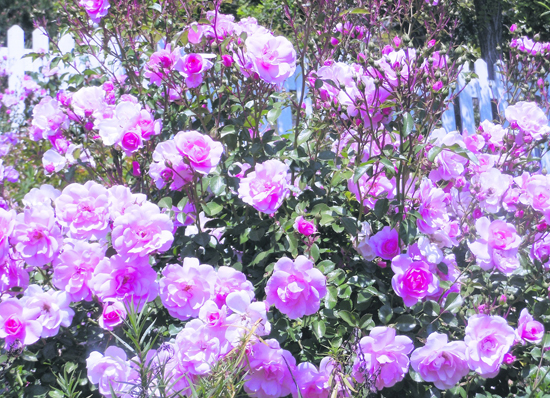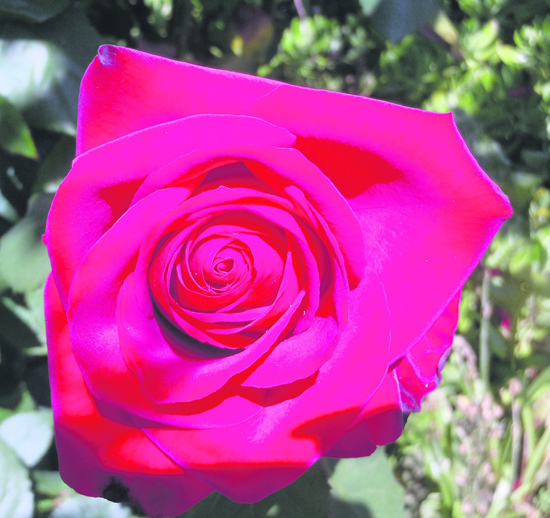| | Published July 6th, 2011
| Digging Deep with Cynthia Brian Life is a Bed of Roses
| | By Cynthia Brian |  | | The prolific pink petals of a Bonica Shrub rose are perfect for borders and a cottage garden. Photos Cynthia Brian
| "Won't you come into my garden? I would like my roses to see you." Richard Sheridan
Poets, philosophers, and politicians praise the potency of the most popular plant in the world as a symbol of beauty, love, politics, and war. These ravishing blooms have been used as celebratory confetti and confections, as legal tender, perfume, cosmetics, decorations, and medicine. Long before man walked the earth, the genus Rosa flourished in Oregon and Montana according to fossil evidence dating back 35 million years. The colorful cultivation of the rose began in China 5000 years ago. Boasting 150 species throughout the Northern Hemisphere and thousands of cultivars and hybrids, 35 rose species are native to the United States, including repeat bloomers.
I adore roses. As Clement of Alexander pronounced, "If I give you a rose, you will not doubt of God," I believe that roses are heaven sent and heaven scent. These most coveted of flowers add the most magnificence to my garden with the least amount of maintenance. Many new gardeners fear roses, mistakenly thinking that roses are difficult to grow.
It takes no special skill or garden acumen to have roses trapeze on trellises, climb arbors, billow in borders, spill over pergolas, decorate doorways, and magically transform a dining table. Whether roses are trained and coddled in a formal bed, or grow in wild profusion, cottage style, the rose is the queen of any garden plan. Shrub roses and old garden roses are especially popular as gardeners realize that roses are not very demanding, most requiring a minimum of disease control. Roses provide abundance in floral displays, sweet scents, and are winter hardy. They add color, texture, form, and depth to any perennial patch.
To grow healthy, beautiful roses, you need to follow only three steps:
1. Choose the correct plant for your area.
2. Plant the rose in a sunny spot that shines at least six hours of bright light per day.
3. Water appropriately.
Before you run out to buy roses, let me provide a primer on growing roses and the choices you'll encounter. Depending on where you anticipate planting, factors to consider include flower color, size of the rose bush, growing habits, and disease resistance. For example, you may want a formal rose garden off your living room as I have with specific colors that reflect your interior design. Or you may be creating a cutting garden and want bountiful blooms in a rainbow of colors. The most important thing to remember with growing roses is to provide ample sunshine away from large trees and shrubs competing for sun, nutrients, and water. As in real estate, roses are about location, location, location. Everything else can be augmented or changed.
Choices
Rose choices with personalized characteristics include
- Hybrid Tea
- Floribunda
- Grandiflora
- Tree
- Climber
- Miniature
- Shrub and Landscape
Hybrid teas are tall, long stemmed, and popular for floral bouquets. They are the most popular cutting rose and are used by florists featuring a single specimen.
Floribundas are versatile roses with clusters of three to fifteen blossoms instead of a single stem.
Grandifloras are repeat bloomers growing to six feet and are a cross between a hybrid and floribunda.
Tree roses are elegant, stately specimens grafted to a long stem from hardy wood stock that is then grafted to the top of a stem on a rose bush.
Climbers produce long canes with numerous flowers that can be trained over archways, along fences, pergolas, trellises, or other sturdy structures.
Miniatures are the smallest rose plant ranging from six inches to two feet, extremely hardy with continuous blooming flowers. They are great for containers, borders, and anywhere space is an issue.
Shrub and landscape roses are the newest favorite of almost every gardener because they require a minimum of care, including little pruning, spread low to the ground like a carpet, are naturally disease resistant, flower consistently throughout the season, and come in all colors, shapes, and sizes.
Grades
The American Nurseryman Association sets the grades on roses as 1, 1 1/2, and 2. The highest quality for the biggest and best canes that will bloom the first year is #1. Although the other grades cost less, they may take two or more years to bloom. A patented rose is registered by the breeder and simply means that no one else may duplicate or propagate it without permission, including taking cuttings.
After choosing the sunny location for optimal growth, these are the simple planting instructions:
- Soak roots in a bucket of water for a minimum of one hour when planting bare root. Thoroughly water a container rose for two days before planting.
- Prepare the soil by tilling compost and other organic matter. Roses thrive in acidic soil. Adding your coffee grinds will enhance the growing. Gypsum and soil sulfur reduce the alkalinity.
- Dig the hole twice the size of the root ball and plant to the same depth.
- Plant roses three feet apart and away from other large bushes to allow for air circulation. Air movement discourages disease.
- Make sure the graft (the raised bump on the stem) is planted at least two inches above the dirt here in our warmer climates of Lamorinda. If you are planting another garden in a colder region, the graft goes two inches below the ground.
- Layer three inches of rich mulch at the base of the plant. It keeps down weeds, provides nutrients, and can be added any time during the growing season. Good mulches include wood chips, shavings, shredded bark, pine needles, cottonseed, chipped oak leaves, and peat nuggets.
- Water adequately from the bottom. Roses do not like to be sprayed. Keep moist, but not soaked.
My secret to healthy roses is that when planting, then again every March, I dig two or three cupfuls of alfalfa pellets into the dirt around the roses. Roses are heavy feeders. Start fertilizing with an organic rose fertilizer after a month. The more organic matter you use, including coffee grinds, the less supplemental fertilizer you'll need.
Companions
Many people like to combine other specimens with roses. The best companion plants are those with similar needs of sunshine, acidic soil, and water. Alyssum and lobelia are great choices as bottom breeders while lavender and sages offer pest resistance and attract bees and hummingbirds, adding beauty and perfume with their blue and purple flowers.
Care
Buy top quality roses for the best pest prevention precaution. If planted, watered, and fed properly, roses are healthy and prolific. If you have a specific problem, contact your local nursery or garden center for organic control options.
Deadhead regularly through the blooming season, cutting below the fifth leaf. Keep your pruning shears clean by wiping with alcohol between bushes. Always wear gloves to protect you from the thorns. Pruning promotes vigorous blooming and bigger plants. For the modern varieties, pruning keeps the roses blooming all season. Old-fashioned roses and climbers that bloom once annually need to be pruned immediately after flowering as next year's flowers bloom on this year's wood. For heavy winter pruning, mid to late January is the ideal time to prune roses in Lamorinda. To keep your roses blooming, don't allow the rose hips to form, which are the small reddish fruits that tell the plant it is "going to seed" and done blooming.
This is a short crash course in creating your own bed of roses. May you see life through rose-colored glasses and stop to smell your roses. Once you enjoy the ravishing beauty, flamboyant colors, delectable fragrance, and simple maintenance of the queen flowers, you may join the mantra of Emma Goldman and myself, "I'd rather have roses on my tables than diamonds around my neck!"
|
 | | The classic long stem red rose in a Hybrid Tea is Mr. Lincoln.
|  | | Cynthia's favorite miniature rose, Sunshine Sprinkles, with multiple yellow/tangerine blossoms on 12 inch stems.
| |
CYNTHIA BRIAN'S GARDENING GUIDE FOR JULY
"I don't know whether nice people tend to grow roses or growing roses makes people nice." Roland A. Browne
- HANG canisters to trap yellow jackets only when entertaining outdoors.
Look for holes in the ground where they make their nests and call
Vector Control to spray when you find them. If you buy a commercial
product at your local hard ware store, read directions carefully.
- EMPTY standing water from all containers on your property to deter
the breeding of mosquitoes.
- CONTROL whiteflies with yellow sticky traps.
- MULCH with at least three inches of shredded bark, wood chips, or
rich compost to keep weeds down and valuable moisture in.
- PINCH herbs before they bolt to keep them producing nutrient rich
flavors!
- DEADHEAD roses when they are spent. Cut back to a stem with five
leaves for continuous flowering through January.
- JOIN a garden club if you want to commune with other dirt diggers.
- DETER the slugs, snails, and cutworms by sprinkling eggshells around your vegetables. As a bonus, they provide rich organic fertilizer.
- PHOTOGRAPH your garden every month so you'll have a visual map of
what blooms and ripens. Photos help with planning, planting, and partying.
- GET a tetanus shot if you have not had one within the last ten years.
Tetanus loiters in the dirt.
- WEAR boots and gloves in the garden as well as long pants and long
sleeves when mowing lawns or using any pest control, even if it is organic.
- ELIMINATE ants by spreading bay leaves from our numerous Califor
nia Bays and mint leaves at their point of entry. Adding rosemary or sage
to the barbecue while grilling willalso keep the crawlies away.
- DEDUCT $1.50 from your garbage bill by composting as I've been
encouraging for years. Go to http://www.wasstefiversion.org/certification,
answer a few questions, submit a photo, and keep the change. I am a fan of
the Smith & Hawken Biostack. Purchase it at a deep discount from your
waste management company. It keeps the critters out and the worms in
resulting in rich, loamy compost in three or four months.
- CLEAR brush from the perimeter of your home. Weeds and dead limbs
pose a fire danger.
- THIN fruit trees for a larger and tastier crop.
- CLEAN and fill bird feeders to keep a gardener's best friend at home.
Babies are hatching this month. Help the mothers feed their young.
- ADD pesticide and insecticide free rose petals to salads, sauces, and
soups to spark the flavor and color quotient of your outdoor meals.
Enjoy a red, white, and blue July, go into your garden and pontificate like a poet, philosopher, or politician.
Your roses are waiting to greet you.
Happy Gardening to You!
(c)2011 Cynthia Brian
The Goddess Gardener
Cynthia@GoddessGardener.com
www.GoddessGardener.com
925-377-7827
My virtual door is always open. I am available as a speaker and consultant. Feel free to contact me.
| | | | | | | | Advertisement | | |
| | | print story
Before you print this article, please remember that it will remain in our archive for you to visit anytime.
download pdf
(use the pdf document for best printing results!) | | | Comments | | |
| | | | | | | | | | | | | | | | |




